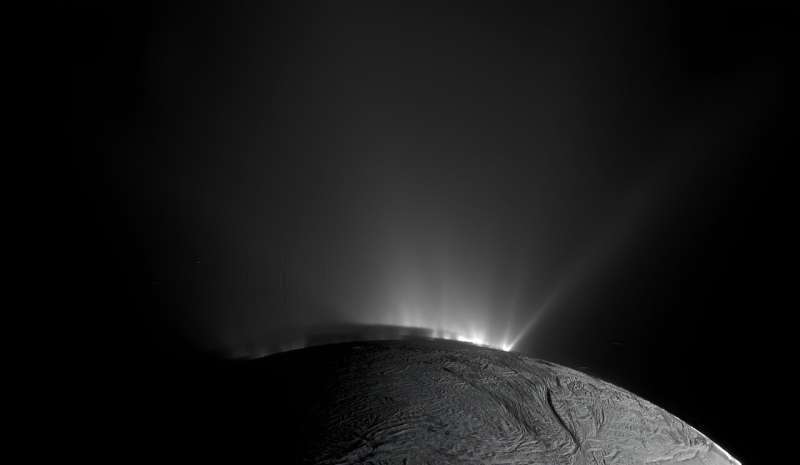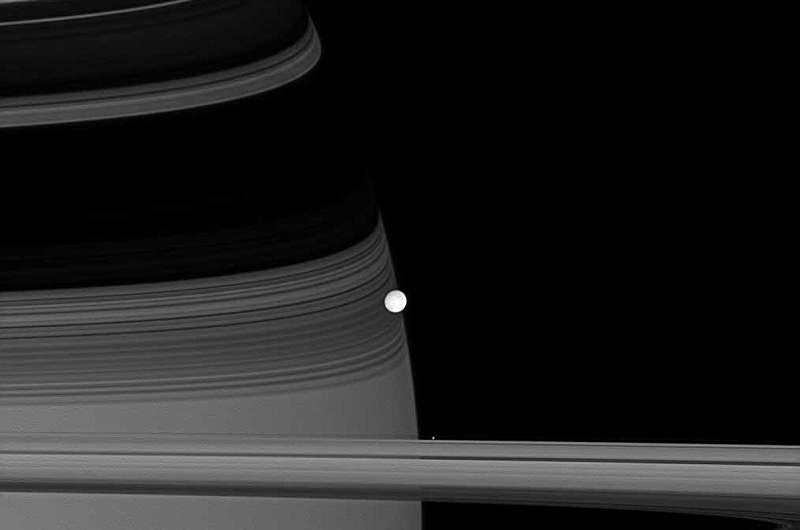This article has been reviewed according to Science X's editorial process and policies. Editors have highlighted the following attributes while ensuring the content's credibility:
fact-checked
peer-reviewed publication
trusted source
proofread
NASA study finds life-sparking energy source and molecule at Enceladus

A study zooms in on data that NASA's Cassini gathered at Saturn's icy moon and finds evidence of a key ingredient for life and a supercharged source of energy to fuel it.
Scientists have known that the giant plume of ice grains and water vapor spewing from Saturn's moon Enceladus is rich with organic compounds, some of which are important for life as we know it. Now, scientists analyzing data from NASA's Cassini mission are taking the evidence for habitability a step further: They've found strong confirmation of hydrogen cyanide, a molecule that is key to the origin of life.
The researchers also uncovered evidence that the ocean, which is hiding below the moon's icy outer shell and supplies the plume, holds a powerful source of chemical energy. Unidentified until now, the energy source is in the form of several organic compounds, some of which, on Earth, serve as fuel for organisms.
The findings, published in Nature Astronomy, indicate there may be much more chemical energy inside this tiny moon than previously thought. The more energy available, the more likely that life might proliferate and be sustained.
"Our work provides further evidence that Enceladus is host to some of the most important molecules for both creating the building blocks of life and for sustaining that life through metabolic reactions," said lead author Jonah Peter, a doctoral student at Harvard University who performed much of the research while working at NASA's Jet Propulsion Laboratory in Southern California.
"Not only does Enceladus seem to meet the basic requirements for habitability, we now have an idea about how complex biomolecules could form there, and what sort of chemical pathways might be involved."
Versatile and energetic
"The discovery of hydrogen cyanide was particularly exciting because it's the starting point for most theories on the origin of life," Peter said. Life, as we know it requires building blocks, such as amino acids, and hydrogen cyanide is one of the most important and versatile molecules needed to form amino acids. Because its molecules can be stacked together in many different ways, the study authors refer to hydrogen cyanide as the Swiss army knife of amino acid precursors.
"The more we tried to poke holes in our results by testing alternative models," Peter added, "the stronger the evidence became. Eventually, it became clear that there is no way to match the plume composition without including hydrogen cyanide."

In 2017, scientists found evidence at Enceladus of chemistry that could help sustain life, if present, in its ocean. The combination of carbon dioxide, methane, and hydrogen in the plume was suggestive of methanogenesis, a metabolic process that produces methane. Methanogenesis is widespread on Earth and may have been critical to the origin of life on our planet.
The new work uncovers evidence for additional energy chemical sources far more powerful and diverse than the making of methane: The authors found an array of organic compounds that were oxidized, indicating to scientists that there are many chemical pathways to potentially sustain life in Enceladus' subsurface ocean. That's because oxidation helps drive the release of chemical energy.
"If methanogenesis is like a small watch battery, in terms of energy, then our results suggest the ocean of Enceladus might offer something more akin to a car battery, capable of providing a large amount of energy to any life that might be present," said JPL's Kevin Hand, co-author of the study and principal investigator of the effort that led to the new results.
Math is the way
Unlike earlier research that used lab experiments and geochemical modeling to replicate the conditions Cassini found at Enceladus, the authors of the new work relied on detailed statistical analyses. They examined data collected by Cassini's ion and neutral mass spectrometer, which studied the gas, ions, and ice grains around Saturn.
By quantifying the amount of information contained in the data, the authors were able to tease out subtle differences in how well different chemical compounds explain the Cassini signal.
"There are many potential puzzle pieces that can be fit together when trying to match the observed data," Peter said. "We used math and statistical modeling to figure out which combination of puzzle pieces best matches the plume composition and makes the most of the data, without overinterpreting the limited dataset."
Scientists are still a long way from answering whether life could originate on Enceladus. But as Peter noted, the new work lays out chemical pathways for life that could be tested in the lab.
Meanwhile, Cassini is the mission that keeps giving—long after it revealed that Enceladus is an active moon. In 2017, the mission ended by deliberately plunging the spacecraft into Saturn's atmosphere. "Our study demonstrates that while Cassini's mission has ended, its observations continue to provide us with new insights about Saturn and its moons—including the enigmatic Enceladus," said Tom Nordheim, a JPL planetary scientist who's a co-author of the study and was a member of the Cassini team.
More information: Jonah S. Peter et al, Detection of HCN and diverse redox chemistry in the plume of Enceladus, Nature Astronomy (2023). DOI: 10.1038/s41550-023-02160-0
Journal information: Nature Astronomy
Provided by NASA





















